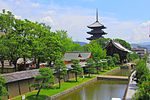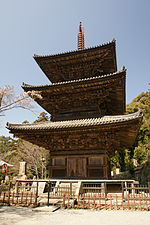the three most important Zenshūyō buildings. Kōzan-ji's butsuden (built in 1320) is the oldest extant building in the Zenshūyō style in Japan. At the end...
11 KB (1,321 words) - 11:22, 19 February 2024
elements evolved into the Zenshūyō style, seen later on in the Kamakura period. This style utilizes the "hidden roof" innovation. Zenshūyō style temples, such...
14 KB (1,583 words) - 14:25, 3 January 2025
important Buddhist architectural styles in Japan along with Daibutsuyō and the Zenshūyō, which were developed based on Chinese architectural styles from the Kamakura...
5 KB (553 words) - 23:25, 25 December 2024
completed in 1320, is a National Treasure of Japan. This architecture in Zenshūyō (禅宗様) (aka Zen'yō) style (Zen style), combining Japanese and Chinese Buddhist...
2 KB (147 words) - 03:32, 14 September 2024
emerged in the late 12th or early 13th century. Together with Wayō and Zenshūyō, it is one of the three most significant styles developed by Japanese Buddhism...
8 KB (932 words) - 20:54, 20 April 2024
elements from three different antecedent styles: wayō, daibutsuyō, and zenshūyō. It is exemplified by the main hall at Kakurin-ji. The combination of wayō...
2 KB (141 words) - 20:09, 30 October 2023
architecture, creating the Daibutsuyō and Zenshūyō styles. The Wayō style was combined with Daibutsuyō and the Zenshūyō to create the Shin-Wayō and the Setchūyō...
91 KB (11,222 words) - 13:43, 13 January 2025
mikkyō sects Tendai and Shingon Buddhism. The Daibutsuyō style and the Zenshūyō style emerged in the late 12th or early 13th century. The following Japanese...
99 KB (11,929 words) - 06:03, 10 February 2025
below), extending laterally the support provided by the system. Wayō-, Zenshūyō- and Daibutsuyō-style tokyō all differ in details, the first being the...
11 KB (1,354 words) - 07:09, 25 December 2024
the Amida Hall at Jōdo-ji are the only extant examples of this style. Zenshūyō – A style that takes its name from its creators, the Buddhist Zen sect...
49 KB (6,035 words) - 21:10, 27 October 2024









